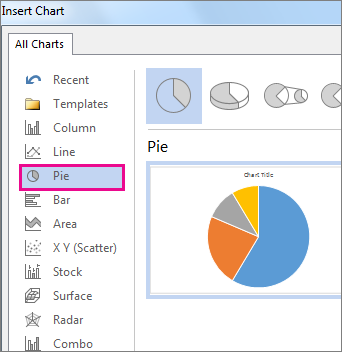

- HOW TO DO PIE CHARTS IN EXCEL 2013 HOW TO
- HOW TO DO PIE CHARTS IN EXCEL 2013 FULL
- HOW TO DO PIE CHARTS IN EXCEL 2013 SOFTWARE
- HOW TO DO PIE CHARTS IN EXCEL 2013 SERIES
Then we will see the already familiar window. For this push the right button of the mouse on any of the blue bars. Here we again deal with the menu Select Data. Your Gantt chart in Excel should look something like this.Ī. Fill in two fields exactly in the same way as we did it above.

Click on Add button under Legend Entries (Series) line.ī. The same procedure is used to add the duration of each assignment in your Gantt chart.Ī. Here is what you are supposed to see after all those steps. Now all your start dates are included in your chart. Your dates will be entered into the field in that window. Then click again on that small icon on the right of the field. Choose the cell with your first date (in my case it is ) and drag your mouse down to the last one. Let’s proceed to the second field where dates should be entered. Thus we will move this phrase into the chart.
HOW TO DO PIE CHARTS IN EXCEL 2013 SERIES
Click on Series Name and after it on the column header with the phrase Start date in your table. There are two fields, and all of them we need to fill in. Go in there a little bit down and to the left where you will find Legend Entries (Series) line. Right-click on any empty space in your blank chart. Then we need to do a few clicks in order to transfer the data from the table into our Gantt chart.Ī. Add start dates and duration of your tasks

Thus you inserted a blank window where you will create your Gantt chart.ģ. In the menu that drops down choose a stacked bar.ĭ. Create your Gantt chart using a stacked barĬ. Here what I have for the project connected with event planning.Ģ. Here we put down all information that is necessary for a project – tasks, their start/end dates and duration of each responsibility expressed in days. Actually, there is no big difference between Excel 2010, Excel 2013 or Excel 2016.
HOW TO DO PIE CHARTS IN EXCEL 2013 HOW TO
If you set your mind on creating your chart in Microsoft product, here is step-by-step instruction how to do it in Excel 2010. Such a principle is implemented in standard Gantt chart software, Excel is no exception here. So, anyone who decides to use a Gantt chart for project management has duties and timeframes visualized in front of them.
HOW TO DO PIE CHARTS IN EXCEL 2013 SOFTWARE
This chart that was devised by Henry Gantt to show a project schedule has common features with no difference what software you use.Ī Gantt chart consists of lines expanded along a timeline. However, it is much better to use special software and create Gantt charts in GanttPRO, for example. Or you can even try unexpected for this case solutions and make a Gantt chart in PowerPoint or, surprisingly, in Word. Add start dates and duration of your tasksĪ Gantt chart in Excel is like any other Gantt chart in other tools.įor example, you can create a Gantt chart in MS Project, the popular, yet hard-to-learn tool.Create your Gantt chart using a stacked bar.

You can also use an Excel template like Gantt chart Excel to create a Gantt chart. Have you ever heard about it? If no, you will find this article useful as here we present a step-by-step tutorial on how to make a Gantt chart in Excel. Probably, you will be surprised, but users do not even realize the full-featured power of Microsoft Excel.įor example, you can use it in project management with the help of Gantt charts that you can create right inside of it.
HOW TO DO PIE CHARTS IN EXCEL 2013 FULL
The full list of its features is really long so one can do many operations in it: calculate, create pivot tables, charts, sparklines, etc. Thousands of people use it every day with different aims be it something for your office needs or at home.Įxcel is very popular software presented in a spreadsheet form. This office suite includes a variety of useful apps for convenient day-to-day work. You hardly meet someone who never heard about Microsoft Office and Microsoft Excel in particular.


 0 kommentar(er)
0 kommentar(er)
